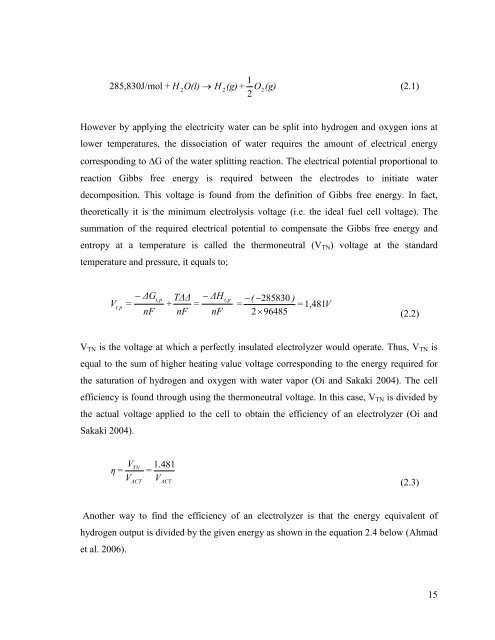hydrogen production from water using solar cells powered nafion ...
hydrogen production from water using solar cells powered nafion ...
hydrogen production from water using solar cells powered nafion ...
Create successful ePaper yourself
Turn your PDF publications into a flip-book with our unique Google optimized e-Paper software.
1<br />
285,830J/mol + H 2O(l)<br />
→ H 2(g)<br />
+ O2(g)<br />
2<br />
(2.1)<br />
However by applying the electricity <strong>water</strong> can be split into <strong>hydrogen</strong> and oxygen ions at<br />
lower temperatures, the dissociation of <strong>water</strong> requires the amount of electrical energy<br />
corresponding to ∆G of the <strong>water</strong> splitting reaction. The electrical potential proportional to<br />
reaction Gibbs free energy is required between the electrodes to initiate <strong>water</strong><br />
decomposition. This voltage is found <strong>from</strong> the definition of Gibbs free energy. In fact,<br />
theoretically it is the minimum electrolysis voltage (i.e. the ideal fuel cell voltage). The<br />
summation of the required electrical potential to compensate the Gibbs free energy and<br />
entropy at a temperature is called the thermoneutral (VTN) voltage at the standard<br />
temperature and pressure, it equals to;<br />
V<br />
t, p<br />
− ∆G<br />
=<br />
nF<br />
t, p<br />
T∆∆ − ∆H<br />
+ =<br />
nF nF<br />
t, p<br />
−(<br />
−285830<br />
)<br />
= = 1,481V<br />
2×<br />
96485<br />
(2.2)<br />
VTN is the voltage at which a perfectly insulated electrolyzer would operate. Thus, VTN is<br />
equal to the sum of higher heating value voltage corresponding to the energy required for<br />
the saturation of <strong>hydrogen</strong> and oxygen with <strong>water</strong> vapor (Oi and Sakaki 2004). The cell<br />
efficiency is found through <strong>using</strong> the thermoneutral voltage. In this case, VTN is divided by<br />
the actual voltage applied to the cell to obtain the efficiency of an electrolyzer (Oi and<br />
Sakaki 2004).<br />
η=<br />
V<br />
V<br />
TN<br />
ACT<br />
1.481<br />
=<br />
V<br />
ACT<br />
(2.3)<br />
Another way to find the efficiency of an electrolyzer is that the energy equivalent of<br />
<strong>hydrogen</strong> output is divided by the given energy as shown in the equation 2.4 below (Ahmad<br />
et al. 2006).<br />
15

















